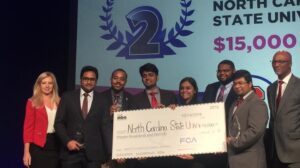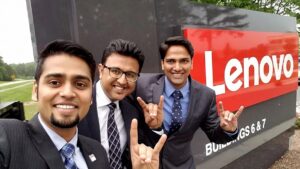Vishnu Kotipalli MBA/MIE’18: A Testament to Academia’s Impact on Industry

Vishnu Kotipalli graduated from NC State in 2018, having earned both a Master of Business Administration (MBA) degree and a Master of Industrial Engineering (MIE) degree through the Poole College of Management’s dual-degree program.
In this interview, Kotipalli discusses what sparked his initial interest in supply chain management, his student experience at NC State and with the SCRC, and how he’s now applying those experiences as a Senior Strategy Manager of Supply Chain at Lenovo, where he’s helping to lead the company through a five-year supply chain transformation.
How did you go from studying biotechnology and software development to coming to NC State for your MBA in supply chain management?
After I graduated in 2011 with my undergraduate degree in biotechnology, I worked for a few years as a program developer at Cognizant, an American multinational Fortune 500 IT solutions company. In that time, I realized how important academic education is for getting a job done properly, so I enrolled in a part-time graduate degree program for software development and management and earned my first master’s degree. After a while, though, I discovered my interests truly lied in optimizing my clients’ business processes and helping them design and develop solutions that would deliver more value. I realized there was a position at Cognizant that does that, all day, every day — a business analyst — but it required an MBA. I challenged that requirement, and they made an exception, given my knowledge of my client’s domain and my technical background. Once again, though, I found that I lacked the academic knowledge to actually do what I set out to do, so I decided to pursue an MBA. Since supply chain is all about end-to-end process and is the backbone of any organization, I decided to come to NC State for my MBA to study supply chain management.
What were your initial experiences like working with the SCRC while earning your MBA?
I received my SCRC scholarship as a Graduate Research Assistant (GRA) at the end of my second semester, so that was really exciting for me, because it really enforced my belief that I would actually do well in supply chain, considering I didn’t have any prior background in supply chain, per se, before coming to NC State. It was pretty daunting for me, because I was trying to change industries, but the SCRC scholarship was really helpful in getting me on the right track.
The SCRC also played a big role in helping me acquire my internship with Ancestry.com. Some of the Ancestry folks are actually NC State alums, too, and they came to NC State to recruit thanks to their relationship with the SCRC and CMC. So it was a combined effort of those two groups that actually got me that internship.
I also did my practicum project with Lenovo during my second semester, which, of course, was facilitated by the SCRC, and was a happy coincidence, given my future work with Lenovo.

Can you describe the project you worked on for your practicum project?
The project involved creating a dashboard for supplier management for Lenovo. We were given the task of figuring out a way to gather all of the unstructured data about the suppliers, and combining it with Lenovo’s internal spend data and performance data to create and present a supplier scorecard based on those metrics. They needed the tool to be dynamic, so our goal was to provide a tool that enables their commodity managers to continuously manage and monitor their suppliers’ health and make better purchasing decisions. We used Excel for it, because Excel is free, and it also has the web crawl feature, which we used to get all of the unstructured data, and then sort of married that with the Lenovo historic data in the dashboard.
Did Lenovo end up applying the dashboard your practicum team created?
Yes, they were able to apply our dashboard as-is, using Excel, until last year, I believe. It was since integrated into Qlik Sense, which Lenovo has decided to use for their data visualization and dashboard purposes.
You also participated in three case competitions as a student. What was that like?
Yes, the case competitions were very exciting. During my first semester in 2016, I participated in the National Black MBA Association Case Competition, which involved developing a short and long-term business strategy for an automobile company, Fiat – Chrysler. I worked with second-year students to create a business plan, and we came in second place. It was a lot of fun, and the prize money was good, too — $15,000!
I also participated in the Merck Grand Business Challenge twice — the first time was in Boston during my second semester. My team didn’t place in the top three, but we competed against some really great schools — 6 of the 8 competing schools were Ivy League. The second time was during my second year when it was hosted at NC State, and my team collaborated with the Questrom School of Business to actually win that one. The scholarship award was $16,000.

How did you go about finding the opportunities for the case competitions?
All credit goes to the NC State MBA office and the MBA Career Management Center (CMC). I was the VP of the MBA Student Association, so I had a lot of interaction with both the MBA office and the CMC, who were very helpful and receptive — the competitions are something that they support if there’s interest from the students. Their support is really valuable, and is something I don’t think a lot of schools offer. In fact, they even pay for everything — the travel, lodging — because the students are representing the university. It’s up to the students to actually take advantage of the opportunities — you know, forming a team, sorting out the logistics — but the CMC is really supportive and provides great opportunities like this. And not just case competitions, but also conferences and networking events. They do a great job of sending information about these opportunities the students’ way.
What other extracurricular activities were you involved in as a student?
I was really involved with the MBA supply chain club as part of my role as VP of the MBA Student Association. Anybody in the college in a master’s program was able to join the club. Students interested in holding an office in supply chain club would submit their application to the MBA Student Association, and the President and I would appoint the officers. They were required to do at least one corporate social activity, two networking events, and one guest-speaking event, and it was our responsibility to make sure these requirements were met.
You actually received a Master in Industrial Engineering (MIE) degree in addition to your MBA. Why did you decide to pursue the dual-degree program?
Well, let me first say that the supply chain courses in the MBA program are fully adequate by themselves to successfully pursue a career in supply chain management. But I finished all those courses in my first year. I did 18 credit hours my first semester and then 17 more my second semester. I did that intentionally so that my second year would be relatively lighter so that I could pursue other interests. But the fact that I was actually able to finish those courses my first year actually left my second year completely open. So, all I really had to do to finish my MBA was pick was a couple of electives each semester. But instead of picking electives just for the sake of picking them, I explored outside of the business school, and came across the dual-degree program that Poole College offers that would allow me to earn an MIE. I found that the MIE courses offer the technical side of the concepts that are taught in the MBA program. What I gained was skills in statistical analysis — things like how to manage, manipulate, and visualize data — things that are entirely technical concepts. Being able to pick up those classes was extremely useful while doing my MBA, because there’s a high degree of overlap and application with what I wanted to do.
How have you been able to apply your dual-degree experience in the workplace?
The MBA helps me prepare, present, pitch, translate quantitative results and communicate those results with my leadership, customers, or partners at Lenovo, and it equipped me with the concepts and domain knowledge of end-to-end supply chain management. Whereas the technical side from the MIE degree actually enables me to go and do the research, identify and collate various data inputs, and use statistical concepts for projects that I wouldn’t otherwise be able to do. And even for projects where I don’t have to work on the technical side, if somebody is pitching to me, or if I have to pitch to someone, I’m able to completely understand and talk intelligently, both financially and operationally.
How did you go about acquiring your first full-time position with Lenovo?
I worked with Lenovo as a process and data analyst intern during my third semester through my SCRC Graduate Research Assistant scholarship, and after I completed my internship, they happened to open up a new strategy position in global supply chain. I had frequently talked about my aspirations during my time as an intern, so they offered me the full-time position once I graduated. I already knew the processes, pain points, and priorities of the organization, and they were already familiar with my performance, so they were comfortable offering me the position by the end of my third semester. I continued to work with them throughout my final semester, and then I joined full-time after I graduated as a global supply chain strategist.

You were recently promoted to Senior Strategy Manager of Supply Chain. Can you describe the work your team is doing?
We’ve been tasked with transforming our supply chain from a cost center to a profit center. Our roadmap is to leverage emerging technologies like Blockchain, AI, and IoT to address the pain points that we face today in our own supply chain, deploy solutions internally, quantify the value, and benefits, and then take it to market and monetize it. Usually supply chains are heavily cost-intensive, and rightfully so, because it’s an expense to the organization to ship inventory or manufacture things. But we realized that if we can find a way to do it better, it would give us a competitive advantage. We also highly value the level of visibility we’re providing our customers in terms of our inventory and our manufacturing process, so our goal is to build a supply chain that actually enhances these customer experience KPI’s, and ultimately be able to monetize the solutions that we’re building by providing them to other companies in the electronics industry who have similar supply chains and pain points. People want a secure, transparent and reliable supply chain, so that’s our goal. We set out in 2017, and it’s a five-year transformation journey we’re on. So far, I think we’re definitely on track!
Learn more about Vishnu on his personal website: VishnuKotipalli.com


